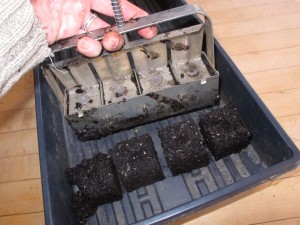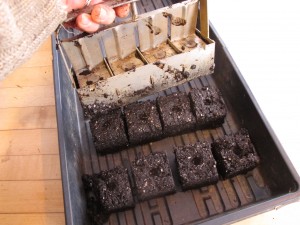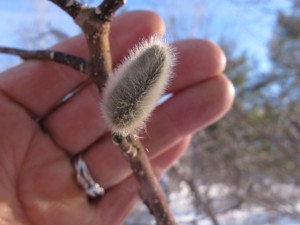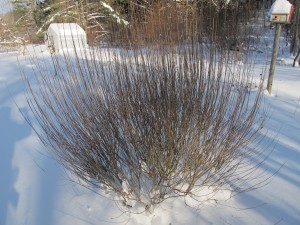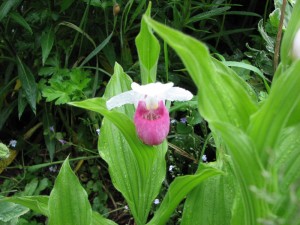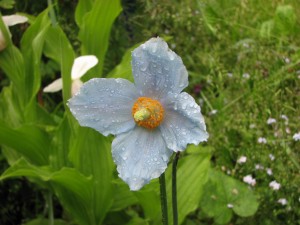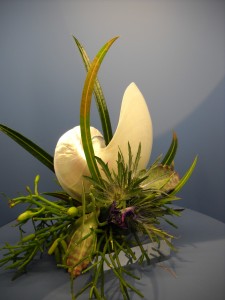Thinking of Spring, Starting a Few Seeds
I’m not sick of winter yet. But I have to admit that recent warm, sunny days got me thinking about spring. I love to start seedlings in the house but recognize that it is still too early for most things. I have a couple of artichoke seedlings growing in a large pot, and will start some onions and peppers by mid-March.
The problem with starting seeds too early is that it is hard to meet the needs of your seedlings until the soil warms up enough to plant them outdoors. I have fluorescent lights and a nice plant stand. But as plants grow, they need bigger pots for their roots. As I start about 300 plants most years, I cannot give each of my babies its own 3- or 4-inch pot after they outgrow the six-packs many of them are started in. The solution? Start most things just six to eight weeks before they go outside – which for tomatoes and other frost sensitive plants is, for me, June 1oth even later.
Most commercial seed starting mixes are made of peat moss, perlite (a fluffy white substance that looks like Styrofoam), and some soluble chemical fertilizer. The assumption is that the mix will get plants off to a good start by providing a fluffy medium for young roots – but that you, the grower, will supply the “food” that your seedlings want after the first month.
After a month the chemical fertilizer will have either washed away or been used up. So what should an organic gardener do? There are fish or seaweed derived liquid fertilizers that you can dilute and add to the water you apply. They will supply the nitrogen, phosphorus and potassium found in a chemical fertilizer, and they will also supply calcium, magnesium, and many other chemical elements needed by your seedlings in small quantities.
Another solution, and one I favor, is to make a 50-50 mix of commercial potting mix with compost. My compost pile is frozen solid, but a good commercial compost such as Moo-Doo will do just fine – it will have healthy microorganisms in it. These bacteria and fungi help to process organic matter and turn it into chemicals that are easily absorbed and used by your seedlings.
Another technique is to make soil blocks using a small metal press that allows you to make 2-inch cubes of a packed soil mixture. This technique is more work, but provides high quality nutrition to your plants, and minimizes root shock when planted outdoors – seedlings grown in plastic six packs usually have tangled roots by the time they go outdoors, but plants started in soil blocks will not.
To make enough mix for about 300 blocs, mix the following ingredients in a wheelbarrow:
10 quarts of dry peat moss
1/4 cup limestone
1 cup azomite or granite dust (optional)
Then add and mix well:
10 quarts coarse sand,
10 quarts of peat humus,
1/2 cup colloidal or rock phosphate
1/2 cup green sand
1/2 cup organic blood meal
Finally add and mix well :
8 quarts of compost (your own or purchased)
8 8 quarts of garden soil or purchased topsoil.
The mix is somewhat dry, and needs to be moistened and used in small batches. For a start, mix 4 quarts of mix with 1-2 quarts of water, stirring it with your hand (wearing a rubber glove). It should be gooey, but firm, not watery. Experiment with it until you find just the right consistency.
To make the blocs, make a pile of the gooey stuff 4-5 inches deep in a recycling bin or other flat-bottomed container. Then compress it by squishing it with the block maker, which makes four 2-inch cubes at a time. Fill up the cavities of the blocker, and then get rid of any excess by pushing the block maker down and rotating it against the bottom of the bin.
You can eject the blocks with the squeeze of the spring-equipped handle into in a standard black plastic flat, which will just hold 32 blocks. Line up the rows of blocs so that they do not touch. Block makers are available from Johnny’s Seeds and the Fedco Seed Company. And if you don’t want to make your own mix, some companies such as Grow Compost of Vermont are making a mix suitable for block makers.
Starting seeds is not for everyone, but I love it. It keeps me from getting squirrely as winter morphs into mud season while waiting for the snow and ice to disappear. Give it a try if you haven’t.
Henry teaches gardening and pruning to groups and individuals. His web site is www.Gardening-Guy.com.
Enjoying the Winter Landscape
I like winter. I like the special quality of winter light in the late afternoon, those purples and blues that were perfectly captured by artist Maxfield Parish. But most of all, I like passing through the woods on skis when the sun is bright. The snow sparkles the way diamonds might, if scattered on a Mediterranean beach.
I visit the woods in winter for the same reason that I go to museums: for the sheer beauty on display. There is something uplifting about great works of art – or great works of nature. I don’t need to go to the Grand Canyon to feel awe; I can enjoy the woods near home just as much. Part of the joy for me is going slowly enough to see what’s there, and taking time to appreciate the details.
As I approach my favorite woods, stolid maples wait patiently along the lane, old and venerable. They will share their sweet nectar in another month or two but for now they stand silently, motionless, waiting.
In the forest, young hemlocks bend under the weight of snow, their long arms reaching to the ground for stability, green fingers disappearing into the snow. Going through glades of mature hemlocks or pines, their branches reaching out high above me, is almost like visiting a great cathedral. I like the wisps of snow that blow off their branches – snow smoke I call it – even if some goes down my neck.
Teenage beeches are the glamour stars of the woods, their bark smooth, gray and unblemished. Young beeches often hold their dry brown leaves until May, and they rustle when I jostle them. But the old beeches seem somber, even sad, and somehow remind me of elephants. They are stolid, unmoving, their grey legs showing wrinkles and scars.
I don’t always have time or the energy to go for a long cross-country skiing adventure. Sometimes I just strap on my snowshoes and go to my garden to look at the silhouettes of trees and shrubs.
One of my favorites is my Merrill magnolia. I planted it some 15 or 20 years ago as a specimen tree in the middle of a mowed lawn. Now it is near maturity: 25 or 30 feet tall with a “wing span” of 20 feet. It has multiple stems, as many magnolia do, and smooth gray bark. The branches are loaded with large, fuzzy flower buds. These buds are bigger and better than pussy willow blossoms, and they bring joy not only for their looks now, but also for the image of what the blossoms will look like: 3-inch double white flowers that are lightly fragrant. The tree almost always blooms for me on April 23, my birthday.
I love the curlicue form of purple-leafed, twisted hazelnut (also called Harry Lauder’s walking stick). It is a very interesting silhouette against the snow, and come spring it will produce lovely, glossy purplish leaves. Later in the summer the leaves will lose some of their purple hue and appear more green.
My apple trees can be a joy to look at, too. Proper pruning of apple trees can turn them into works of art. The key is to get rid of the clutter that apple trees seem determined to grow. Annual pruning to get rid of those vertical twigs called “water sprouts” makes a big difference. I tell people that a bird should be able to fly through an apple tree and not get hurt. I once found the skeleton of a bird in an unpruned apple tree, but don’t know for sure how it met its demise. I’ll start pruning in March, once the snow has melted enough to move around the trees easily.
A native tree that has a great profile is the pagoda dogwood (Cornus alternifolia). It grows branches well separated, so they remind me of person doing Tai chi, holding arms in frozen poses. I have one that grew out of the face of a retaining wall as a ‘volunteer’. Although I snipped it off when young, the roots sent a new shoot, and I let it grow. Now it is a favorite of mine in winter.
My arctic blue willow looks great now, too. It is a ‘nana’ or small variety, and has hundreds of thin twigs growing vertically and very close together. Earlier in the winter it was severely bent over by an ice storm, but I shook the branches free of ice and snow, and now it is back in fine form. The 16 inches of fine snow we got recently sifted through the branches this time, giving it a great silhouette.
So go outside and really look at the “bones” of your garden on a snowy day. And if you don’t find much to look at, make plans to buy and plant some nice trees and shrubs, come spring.
Correction: A kindly soils professor e-mailed me about a recent article in which I said wood ashes could be used to substitute for limestone. He noted that trees can pick up lead and cadmium, particularly near roads, so wood ashes are not good to use in the garden. He also said they act so quickly that your soil may become too alkaline and inhospitable to soil microorganisms.
Henry Homeyer teaches pruning and general gardening. His web site is www.Gardening-Guy.com. He is the author of 4 gardening books.
No Green Thumbs!
I’ve been accused of having a green thumb. I don’t. But I can understand why someone might think so. I have lots of successful flowers, shrubs, trees and vegetables growing on my property every year. But I’m willing to bet that I’ve killed more plants than that guy who claims to have a “brown thumb”. I take chances, buying and trying perennials that are outside their normal climatic zone. I try plants that are persnickety, and then try them again after I kill the first ones.
The late author and illustrator Tasha Tudor, a great gardener who lived in southern Vermont, told me once that she buys at least three pots of any new perennial, and then tries them out in different places on her property to see where they do the best. Often she would buy seven or more pots of the same plant. She tried them in places that had more sun, or less. More natural moisture or less. Like me, I bet she tried different amounts of soil additives for the same kind of plant – more compost, more peat moss or limestone, or more sand, for example.
So what makes a successful gardener? Getting the right soil for each plant. Soil is the key to gardening success. This is a good time, in mid-winter, to pause and learn about soils and to think what you might do, come spring.
There are three basic types of soil; sandy soil, loam and heavy clay soils. Most plants prefer, according to the gardening literature, “Moist, rich, well drained soil.” So how do you get that? It takes time and effort.
The soil most plants want has a mixture of particle sizes: small (clay), medium (loam) and large (sand). Very small particles pack together tightly and hold water with their electromagnetic charges. Clay soils do not drain well – they act like a bowl of baking flour. Sandy soils drain too well – like a wire basket full of golf balls. A good soil has some tiny particles, along with larger ones that provide good drainage.
If you have a clay soil, you cannot just add sand. Clay mixed with sand makes a soil that acts like like concrete. Similarly, if you have sandy soil that doesn’t easily hold water, you cannot just add lots of clay. The key ingredients for either soil are compost and other kinds of organic matter such as chopped leaves, peat moss or coir (coconut fiber). Adding compost is, in my opinion, always a good thing.
The great thing about compost is that it adds water-retention abilities (think of it as containing lots of little sponges) as well as living organisms that work well with your plants. But compost adds air spaces, too, so water can drain better in clay soils if you add lots of compost.
Plants thrive in soils that are biologically active: soils that are full of beneficial fungi, bacteria, protozoa. I read once that a teaspoon of healthy soil can contain 5 billion bacteria, 20 million filamentous fungi and a million protozoa. We tend to think of fungi and bacteria as bad: you may think of fungi as the mildews and molds on leaves. Our mothers told us often to wash our hands to keep bacteria out of our mouths. But in the soil there are many more good bacteria and fungi than bad ones.
Chemicals added to your lawn or garden may inhibit the growth and viability of those beneficial microorganisms. Most chemical fertilizers are composed of salts of nitrogen, phosphorus and potassium. Salts dry out living tissue and can easily kill microorganisms. Too much fertilizer can dry out and kill root hairs of your precious plants, too. Farmers talk of fertilizer “burning” the roots of young transplants. That means drying out the root hairs, killing them.
What else can you add to your soil to help it along? Here in the Northeast our rain is somewhat acidic, and that acid dissolves some minerals and washes them away. Plants need calcium and magnesium, both of which wash away in spring rains. You can buy a 50-pound bag of limestone and apply it in small quantities to your lawn and garden. If you get your soil tested, it should give a recommendation for how many pounds of limestone are needed for every hundred square feet of garden.
Please note: there are two kinds of limestone – dolmitic which contains magnesium, and calcitic, which does not. A soil test will tell you which kind to buy. Or, if you are on a budget and have a woodstove, you use wood ashes instead of limestone. Wood ashes are finer than limestone in a bag, so it is incorporated into the soil more quickly. Use wood ashes at the same rate as you would limestone that you purchased.
When the snow goes and the soil thaws, get a soil sample and send it off to your State Extension testing service. It can tell you what might be missing from your soil, the soil acidity, soil type and amount of organic matter. The more you know, the better your plants will grow!
Henry Homeyer is a gardening educator and lecturer with a specialty in organic gardening. His web site is www.Gardening-Guy.com.
Spring Flower Shows
I’m not a big fan of the movies, but I remember a film from the 1960’s that opened with people trudging across a snow-swept plain somewhere in Russia wearing large fur hats and cumbersome boots. Doctor Zhivago, perhaps? Sometimes it seems that we’re all in that movie. If you’re finding winter dreary, you need to go to one of the many Spring Flower Shows – or maybe all of them.
The first flower show each year is the New Hampshire Orchid Society, this year on February 14-16. It is just orchids. Orchids of all kinds, and paraphernalia for orchid growers. Adults are $10, seniors $6, kids under 12 are free. It’s at the Radisson Hotel in Nashua. For info: www.nhorchids.org.
The first big shows are the weekend of February 20-23 with shows in Providence, RI and Hartford, CT. They are both excellent, and worth a visit. They’ll have flowering trees and luscious flowers, a multitude of vendors selling everything from bulbs and cut flowers to books and vases, and of course, educational lectures. The Providence Show has always been one of my favorites. (Full disclosure: I am lecturing Friday and Saturday at the Show in Providence).
This year the Providence Show is including vintage cars in the garden displays. I phoned Chuck Carberry, one of the show’s organizers, who told me that each major exhibit will include an antique or vintage car – from a Model A Ford in a Great Gatsby-themed garden to a ‘70’s Ferrari in an Italian grotto garden. Not only that, the show will feature an old time drive-in theater!
Each year at Providence I love the sand sculpture – castles big enough for children or gnomes – and this year, given the car theme, they are going to have an old fashioned “woodie” made of sand. The sculptors work on their creations during much of the show, so you can see how they do what they do. The same is true of the designers of the various flower exhibits – they are there to answer questions, which is nice. For info go to: www.flowershow.com
The Hartford show is held at the Connecticut Convention Center, which is a great space for such a big show – handy to the interstate, plenty of parking. They pride themselves on their seminars – 12 per day, Friday to Sunday. The Federated Garden Clubs have a big space on the show floor, allowing individual exhibitors to show off their house plants, cactus and arrangements. Tickets are $16, and unlike most shows, they accept cash only! So fill your wallet before you go. Info: www.ctflowershow.com.
The Philadelphia Flower Show is March 1-9. It is the original flower show (having started in 1829) and certainly the biggest and most expensive. Daily tickets are $27 and they sell a VIP all access ticket for $125! But you have to attend at least once in your life. Go during the week when crowds are less, if you can. For info: http://theflowershow.com/ I love this show for its sheer size and diversity. And there are lots of exhibits by ordinary gardeners, which I like.
The Portland, Maine Flower Show is March 6-9 at the Portland Company Complex on Fore St, downtown. Tickets cost $13 in advance. Info: http://portlandcompany.com. This year’s theme is Storybook Gardens.
The Boston Flower Show is another extravaganza. This year, designers have been asked to. “create a small freestanding garden inspired by a scene of romance or seduction from a specific, named piece of literature, a movie or a popular song”. It’s being held March 12-16 at the Seaport World Trade Center. Tickets are $20 – and worth it! For info: www.bostonflowershow.com. Get there at opening time (10am during the week, 9am on the weekend) before the crowds get too big.
After Boston comes The Seacoast Home and Garden Show in Durham, NH on March 29-30. A nice small show with 220 vendors and a reasonable fee to get in – tickets are only $8. Info: www.NewEnglandExpos.com.



